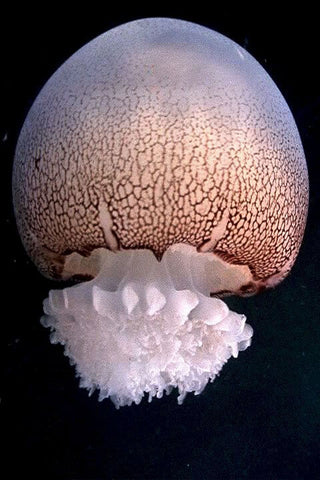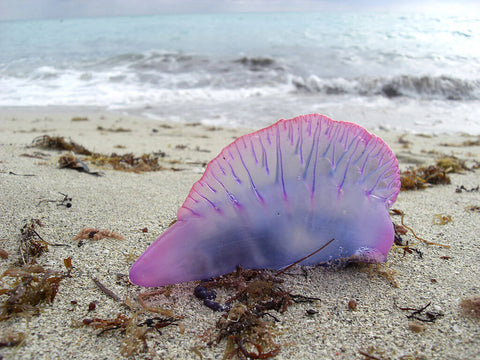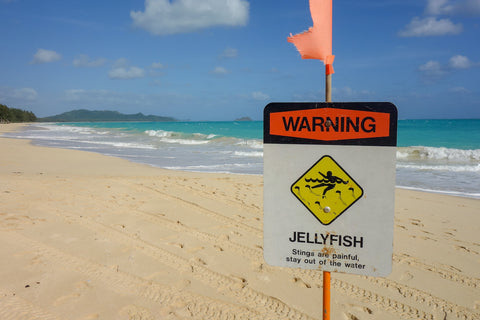
Morey Mach 7 42" Bodyboard
Morey
THE BASICS If you're looking for the perfect mid-range bodyboard, look no further. Built by Morey (the company that invented the boogie board in t...
View full detailsThese painful suckers are easy to miss, but all it takes is a single sting to ruin a relaxing day at the beach.
Before you take a single step on the sand, it's important to know how to treat a jellyfish sting.
Here's everything you need to know about where these sea creatures dwell, how to treat stings quickly, and the warning signs to look out for afterward.
You can find jellyfish in every ocean on Earth. Whether you're in North America or Australia, New York or San Diego, there's jellyfish everywhere. In fact, these sea creatures have roamed our oceans for 500 million years!
Because of this, jellyfish are a recurring problem on beaches, especially in tropical waters.
Contrary to popular belief, jellies do not swim on their own, and instead, follow the natural ocean currents.

Jellyfish also come in many different sizes. From tiny moon jellies to the cannonball jellyfish of the Atlantic, jellyfish are a staple to many beaches, and are certainly here to stay.
Unfortunately, these sea creatures can often be pretty tiny - certainly small enough to be easily missed while walking around on the beach, so it's important to be careful to keep an eye out for them at all times.
Jellyfish will sting to stun their prey. The tentacles on a jellyfish release many barbs filled with venom into the prey. These barbs are on specialized cells in the jellyfish tentacles, called nematocysts.
While humans are not preyed on by jellyfish, they often get stung due to stepping on to a jellyfish body.
We've all seen it - especially those of us on the East Coast, where dozens of jellies often litter the coastline on a morning walk.

It's important to be careful, however. A jellyfish can sting after it has passed away, so try not to touch a jellyfish you find, regardless of if you think it's dead or alive.
When in the surf, avoid heading out on days you see the purple lifeguard warning flag, as this is a signal of dangerous marine life.
Avoiding jellyfish is the key to avoid getting stung, but you'll want to know how to treat the sting if you have gotten stung.

While some jellyfish do sting, not all jellyfish are harmful to humans. In fact, many jellyfish aren't.
There are, however, four main species of jellyfish that are known for extreme stings. Those are:
Treating a jellyfish sting is often about preventing more venom from getting released.
If you've ever been stung by a jellyfish, you'll know when its happened based off the initial rash-like feeling.
As soon as you can, remove yourself from the water. Saltwater is believed to make the stinging worse, so you'll want to get somewhere dry immediately.
Plus, you'll want to make sure you're nowhere near the jelly that stung you.
When a jellyfish stings you, the barbs that they release are filled with venom that can continuously be released into the skin.
This is why jellyfish stings can be so incredibly painful, because it can feel as though you're getting stung multiple times as you move or touch the affected area.
These barbs typically continue to release the venom if they are being provoked.
After removing yourself (or any affected person) from the water, the next best step is to rinse the sting off with a weak acid, such as vinegar.
Doing so will help prevent the barbs from releasing more venom.
Once you've done this, you can follow up by applying some baking soda or shaving cream.
Be very gentle throughout this process to avoid any more stinging.
The next step is to remove the barbs by plucking them out, preferably with tweezers.
Do not try and remove the barbs by rubbing them off or scraping them off.
They will not move, and instead, they will release more venom, causing more pain to your injury.
After you have removed the barbs by using tweezers, you can take a hot shower to help lessen the pain.
Using hot water is your best bet to keep the pain levels low.
Ice or ice packs are not advised to help soothe your sting.
You may have heard the urban myth that peeing on a jellyfish sting helps, but it does not.
In fact, urinating on a sting may further aggravate the stinging barbs, causing more pain.
Avoid using your hands to rinse off or scrape the sting, as rubbing or touching the barbs can cause more pain.
Rinsing the area with fresh water or saltwater may further aggravate the sting as well, so hold off on that until after you've removed the barbs.
An interesting cure, using a meat tenderizer can help as a sting treatment method.
This is because the jellyfish venom is protein-based, and the papain enzyme in the meat tenderizer can break down the proteins, thus decreasing the effects of the venom.
This, however, should only be used as a last-ditch effort. It's better to get the problem taken care of with tweezers early on.
While inconvenient, jellyfish stings are not usually severe enough to warrant a hospital visit.
However, if you or another person has been stung by a jellyfish and starts to develop severe side effects, you will want to visit the emergency center (or, if unavailable, an urgent care center) and see a doctor immediately.
The side effects of a severe reaction include:
● Having trouble breathing
● Getting very dizzy or nauseated
● In an excruciating amount of pain
Once again, if you experience any of these symptoms or side effects, call 911 if necessary and seek medical advice from a doctor immediately. These could be signs of a more serious sting, or an allergic reaction.
To be prepared for your day at the beach, it's recommended that you bring along a small bottle of vinegar and a pair of tweezers.
While you're not likely to get stung often, it's always better to be prepared!

Last but not least, it's important to discuss prevention, as it's the easiest way to not get stung.
So, what can you do to prevent future jellyfish stings?